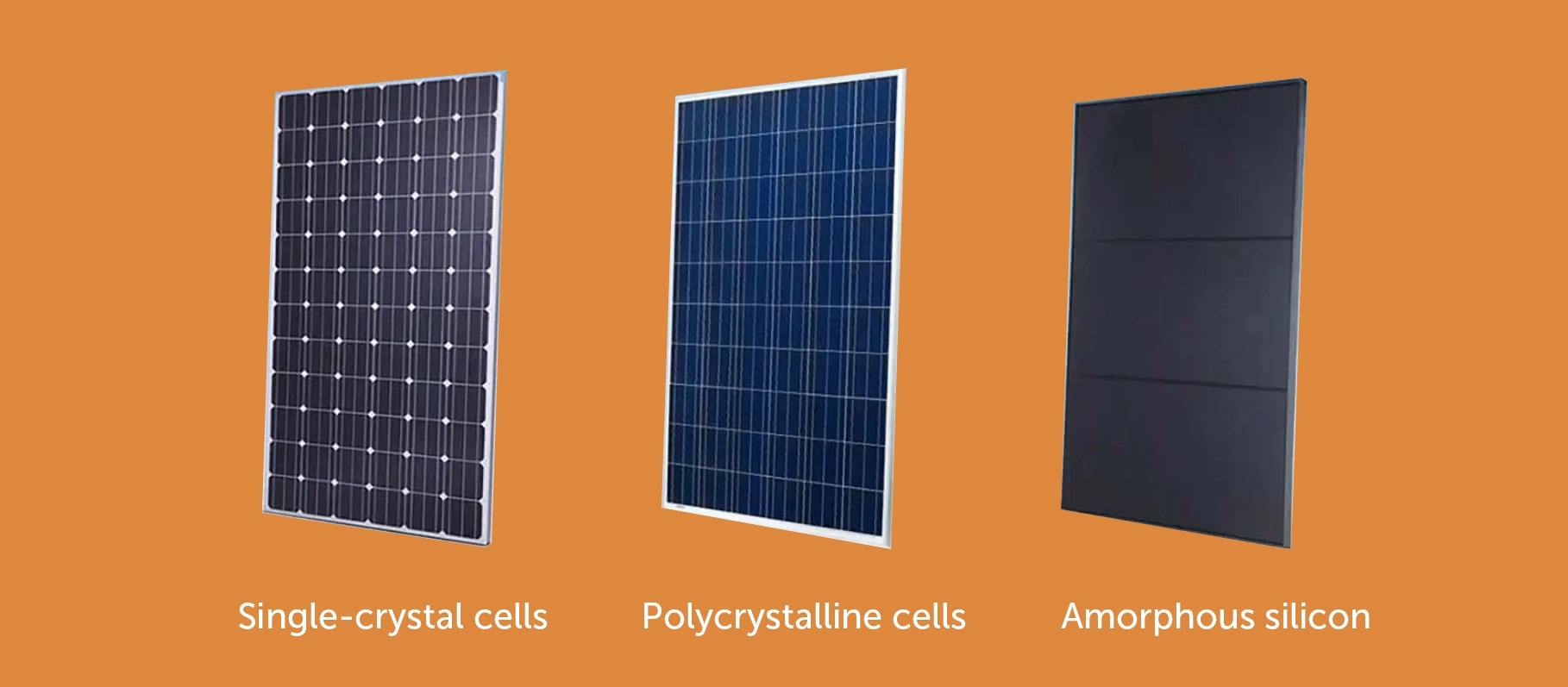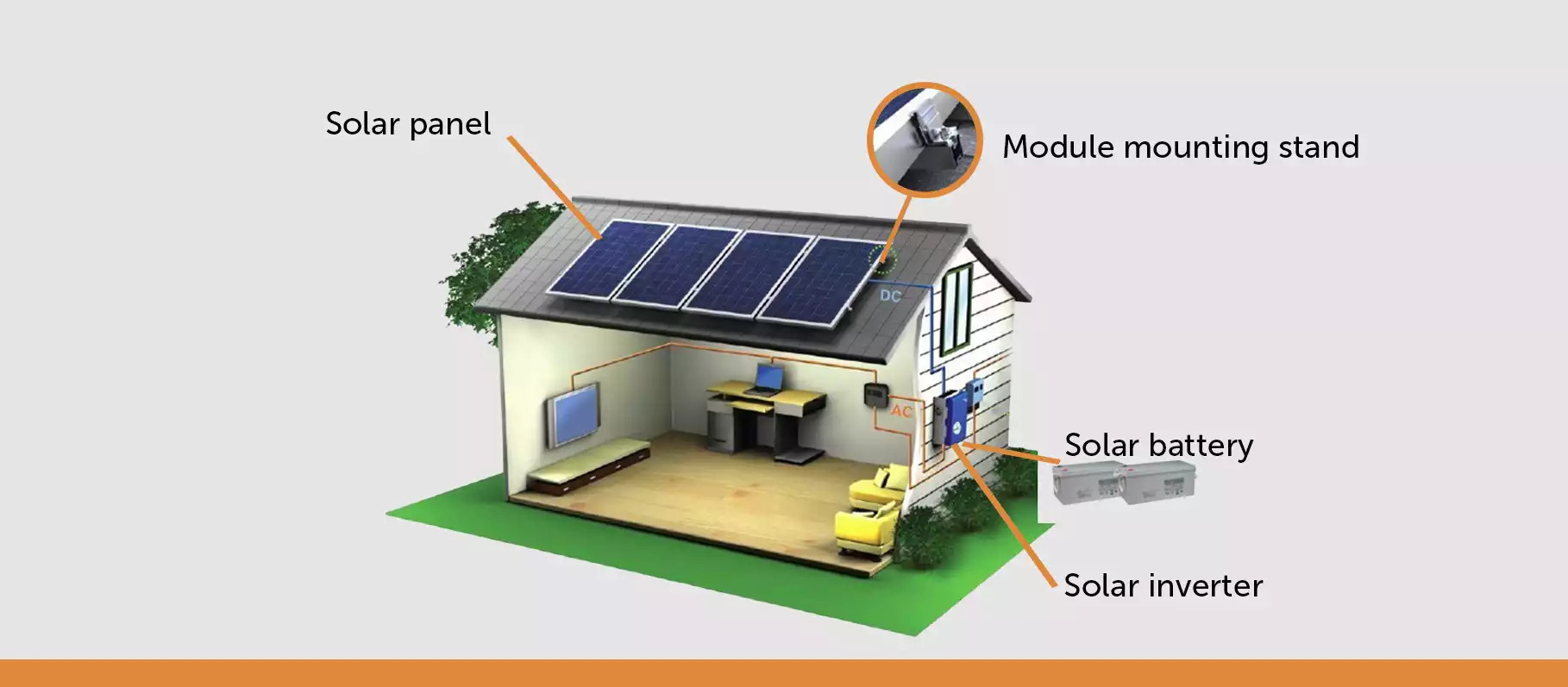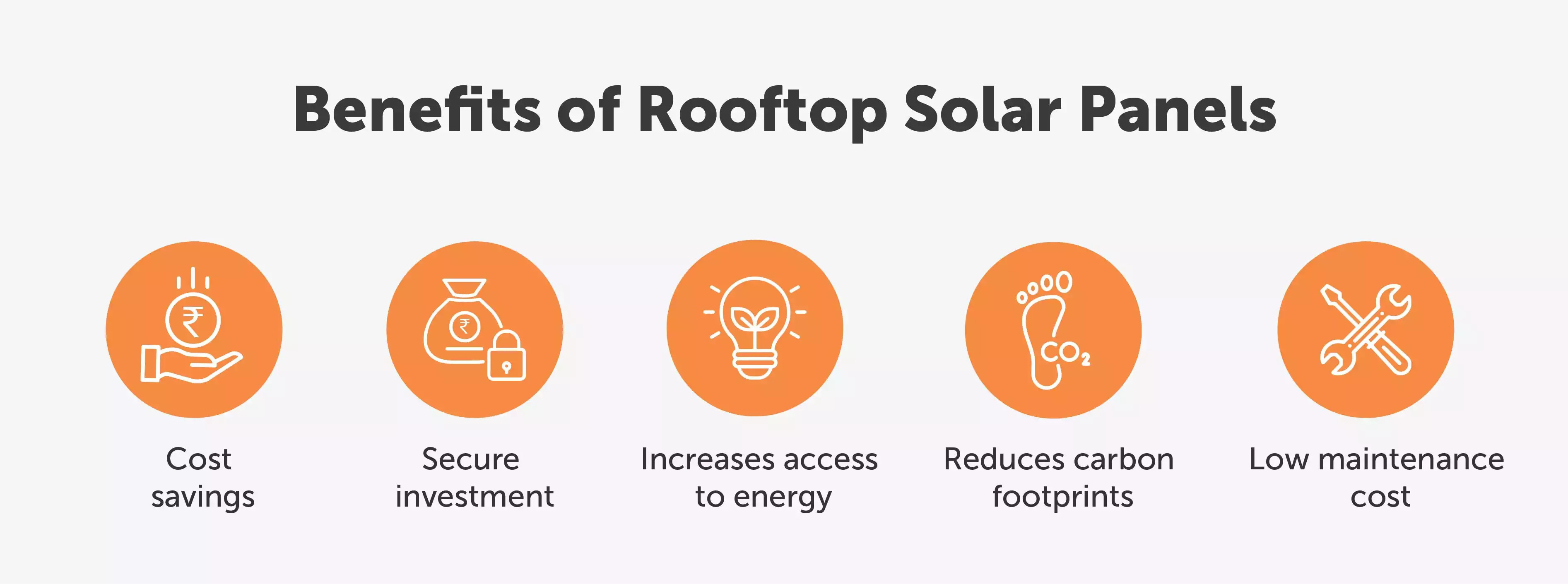Complete Guide About Rooftop Solar System for Home
Complete Guide About Rooftop Solar System for Home
Millions of homes in both urban and rural India have idle rooftops that receive plenty of sunlight during the day. These are ideal for capturing the sun’s energy and converting it into electricity. Why keep rooftop idle when you can generate your own power/ energy from the roof.
This article is curated to act as a go-to guide for solar plant prospects who need to know everything related to rooftop solar panel systems in India. Read on to get answers to questions like what rooftop solar systems are, how much solar roof panels cost and more.
What is A Solar Rooftop System?
Solar rooftop panels as part of solar power systems are installed on the roofs of commercial, industrial and residential buildings. They capture the energy from sunlight and convert it into usable electrical energy. This helps in generating a clean, environmentally-friendly form of energy, emitting no pollution or harmful gases.
Read About: 1kW Solar System Price in India with Subsidy
Contrary to popular belief, harnessing the sun’s power isn’t very complex, and anyone with an idel rooftop can generate their own solar power. Using rooftop solar at homes can help homeowners harness electricity from the sunlight and convert it into electricity for their daily household needs. When photons–lightning energy–hit the rooftop solar panel, the photons are converted to electrons of direct current (DC) electricity. Electricity safety devices can be supplied with direct current electricity. Rooftop solar panels are also equipped with inverters, which convert direct current electricity into alternating current (AC), used by various devices and home appliances such as computers, televisions, and even washing machines.
How does Rooftop Solar Panels for Home work?
Rooftop solar panels rely on inbuilt solar cells to harness solar energy and convert it to electricity. It’s a small, square-shaped semiconductor made of conductive materials like silicon. When sunlight strikes solar cells on a solar panel, it causes a chemical reaction that releases electrons, resulting in the generation of electric current in the form of DC. The majority of rooftop solar panel cells are photovoltaic cells, also found in small appliances such as calculators.
A photovoltaic (PV) cell, or solar cell, is the main functional part of any rooftop solar panel. Photovoltaic cells are of three types:
 Single-crystal cells: These solar cells are made in the form of long cylinders that are cut into hexagonal or round wafers. This type of solar cell operates at higher power, making them more expensive than other types of photovoltaic cells. Installing single-crystal cell modules can increase the efficiency of your home by up to 30%. This type of solar panel accounts for almost 29% of the global solar panel market.
Single-crystal cells: These solar cells are made in the form of long cylinders that are cut into hexagonal or round wafers. This type of solar cell operates at higher power, making them more expensive than other types of photovoltaic cells. Installing single-crystal cell modules can increase the efficiency of your home by up to 30%. This type of solar panel accounts for almost 29% of the global solar panel market.
Polycrystalline cells: These PV cells are made from molten silicon ingots that are then sliced into small squares. The cost of roof solar panel manufacturing having this type of cell is lower, but its efficiency is up to 15% lower than that of single-crystal cells. Because the squares are small, they can be easily packed closely together to increase energy production.
Amorphous silicon: With this type of solar cell, silicon is sprayed in thin films on the glass or metal surface, making the production of such solar cells the least expensive of the three. However, it results in very low efficiency of about 5%.
What are the Main Components of a Rooftop Solar System?
A complete solar panel system, also known as a solar energy system, is made up of four key components:

- Solar panel: A board-like structure with grids that is commonly seen on rooftops. It is the most important component responsible for converting solar energy into electricity.
- Solar inverter: An electrical device that converts the solar panel’s direct current (DC) to alternating current (AC).
- Solar battery: It stores the energy generated by the sun and uses it when the grid turns off.
- Module mounting stand: It is a simple metal structure usually made of galvanised iron. It secures the panels at a specific angle and keeps them from being blown away by the wind.
Apart from the above components, a typical solar panel installation process also requires the following accessories:
- DC wire: A PVC coated wire in two configurations: less than 3kW and a cable tray of 3kW and over.
- AC wire: This connects the inverter to the grid and the home power load.
- DCDB: It protects the panels from the DC side. It is a small solar protection device that is installed between a solar panel and a solar inverter.
- ACDB: It handles the alternating current. It is a small solar device that is installed between the solar inverter and your home load.
- MC4 connectors: single-contact electrical connectors commonly used for connecting solar panels with each other.
- Lightning Arrester (LA): This device protects solar panels and connected appliances from sudden power surges due to lightning strikes. It is compatible with both off-grid and grid-tied solar inverters.
- Earthing kit: 1 to 3 kW: It is done via two earthing. The first is for the inverter, and the second is for the LA(Local Earth). Over 3kW: It is held together by three earthing rods. The extra one here is for PV modules.
Read About: 5kW Solar System Price in India with Subsidy
Benefits of Rooftop Solar Panels
Besides the fact that large-scale installations account for nearly 87 per cent of solar power generation in India, the adoption of solar rooftop panels by households is also rising. Between 2013 and 2022, the installed capacity of the solar rooftop increased from 117 MW to 6645 MW as of Mar 2022. Taking this enormous growth into account, the Ministry of New and Renewable Energy (MNRE), has set a target of 40 GW of rooftop solar power by 2022 through its National Solar Mission of India. There are several reasons why the Indian government is adamant about upscaling solar panel installation throughout the country.
Following are some of the benefits of solar rooftop system:
- Cost savings:
The most significant advantage of installing a rooftop solar panel for home is the cost savings. Rooftop solar tariff rates are 17 per cent and 27 per cent lower than industrial and commercial tariff rates, respectively. Rooftop solar installations are also achieving grid parity in many Indian residential sectors. Rooftop solar installations can even help building owners save money on their electricity bills. Rooftop panels provide electricity to buildings, allowing them to purchase less electricity from the grid and save money on energy costs.
- Secure investment:
Electricity prices are known to fluctuate from time to time. As a result, calculating the cost of electricity for a given period is difficult. When it comes to electricity that is generated by solar rooftops, however, the price of power generated can be easily calculated. One can even calculate the cost of generating electricity for the next ten years. In this sense, it is a safe investment.
- Increases access to energy:
Despite the fact that India’s power shortage is rapidly shrinking, many people in rural and urban areas continue to have an insufficient and unreliable supply of electricity. These people must rely on alternatives such as diesel generators. These alternatives are hazardous to one’s health and environment, and their operating costs are also high. In such cases, solar energy serves as a cost-effective, reliable source of electricity. Rooftop solar panels are environmentally friendly because they use the sun’s energy to generate electricity. Furthermore, their operating costs are consistent.
- Reduces carbon footprints:
Solar panels generate electricity from sunlight, which reduces carbon footprints. As a result, they pose fewer environmental pollution risks than traditional energy sources. They run silently and emit fewer harmful gases than generators. It is also an effective source of energy generation in the fight against climate change. As a result, rooftop solar is ideal for lowering carbon footprints.
- Low maintenance cost:
The fact that rooftop solar panels require very little maintenance is a major factor that emphasises their importance. They have a service life of more than 20 years if properly maintained.
Types of Rooftop Solar Systems
Rooftop solar PV systems are classified into three types:
- Grid-tied: These rooftop solar systems are primarily intended to feed generated power back into the grid while you withdraw power as per your domestic consumption from the grid. During a power outage, the inverter shuts down the system, preventing power from being sent into the grid and avoiding the risk of electrocuting utility workers who are working to repair the grid.
- Grid-interactive: This system works with either a battery backup or a diesel generator to support the load even when the power goes out.
- Off-grid: As the name suggests, this solar power system is not made to work with the grid, rather, it is designed to work only with a battery backup or diesel generator in off-grid applications.
How to choose the Best Rooftop Solar System
How do you pick the best rooftop solar system for your home? Consider the following factors to make the best decision:
Certifications: Just as you would not buy an uncertified or untested electronic device for your home, make sure you follow the same logic when selecting a solar panel. Choose a product that is BIS or Bureau of Indian Standards (formerly ISI or Indian Standards Institution) certified. Installing rooftop solar systems for your home is a significant investment that will last for a long time, so make sure you go with a reputable brand.
Inverter efficiency: A power inverter converts the direct current (DC) current generated by solar panels to alternating current (AC) current, used to power your home. The greater the inverter efficiency, the greater the power output and savings. Consider the inverter efficiency of the solar panels you’re thinking about buying, as this directly impacts how quickly the system will become profitable for you.
Type of panels: To choose the right type of solar panels, consider the space available on your rooftop. There are currently two types available: monocrystalline and polycrystalline. Monocrystalline panels are more efficient and take up less space, but they are also more expensive. Still, both are distinct, and the best option will depend on the amount of space you have available and your budget. Make sure you ask about both before deciding on one for your home.
Cost: When it comes to solar panels, cheap is not always the best option. If you notice a significant price difference, look into other factors such as warranty periods, installation, and equipment quality. Inferior quality components may save you money in the short term, but their cost will add up and affect efficiency and reliability in the long term.
Subsidy For Rooftop Solar System
To encourage the use of solar energy, the Indian government provides subsidies to those who install rooftop solar panels in-home or commercial properties. According to the Ministry of New and Renewable Energy, the government pays the installer 30% of the installation cost as a subsidy.
The Indian government is aiming for a total capacity of 40 GW from rooftop solar (RTS) projects by 2022, 4 GW by grid-tied rooftop solar systems. The solar subsidy adds significantly to the long list of their green energy option benefits. If you’ve been hesitant to go solar because of the high initial investment, the prices of solar power systems for homes in India after subsidy are worth considering.
To put things into perspective, suppose your solar vendor recommends a grid-connected unit with a capacity of up to 3 kWp for your energy needs. Then in that particular scenario, based on the benchmark cost of your home’s first solar plant, you will be eligible for a 40% subsidy (also known as Central Financial Assistance). Moreover, there is a 20% subsidy for units larger than 3 kWp and up to 10 kWp. However, the benchmark cost varies by state, and the subsidy rates also fluctuate based on the state’s solar policy. As a result, it’s critical to work with an experienced solar company to ensure that you take advantage of government-provided financial assistance and lower the total cost of solar panels for your home.

Comments
Post a Comment